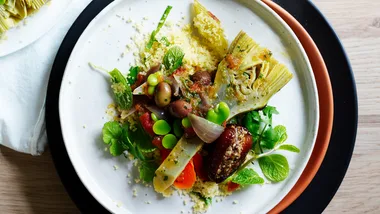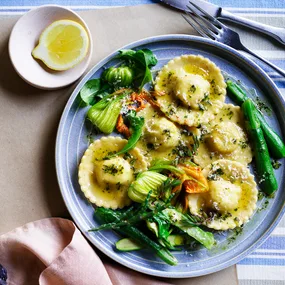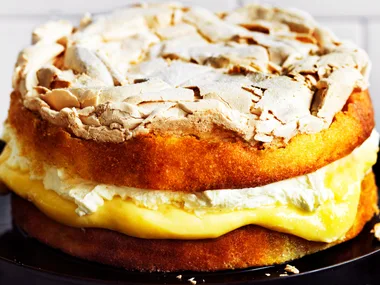When choosing pears for poaching, those in between hard and ripe are best. Ripe fruit will become soft and squishy when poached, whereas unripe fruit will stay hard and discolour. I always buy slightly underripe green pears and let them ripen for several days before poaching. Frangipane is a pastry chef’s staple. Versatile and simple, traditional frangipane owes its distinct flavour to almonds ground with sugar. If you want to flavour up your frangipane, you can easily replace some of the almond with other types of nuts such as pistachios and hazelnuts. I use it as a filling in my fruit tartlets and it can also be baked as a shallow cake.
Find the recipe for puff pastry here.
Ingredients
Frangipane
Method
1.Place sugar and 1 litre water in a wide saucepan that will fit the fruit snugly and bring to the boil, stirring to dissolve the sugar, then reduce the heat to a simmer.
2.Peel pears from stalk downwards, then cut in half lengthways and remove seeds with a melon scoop. Add pears to the simmering syrup and increase the heat. Cover the surface directly with a round of baking paper, then place a plate on top to ensure the fruit stays submerged. Bring syrup to the boil, then reduce the heat to low so the syrup is just simmering and gently poach the pears until you can easily pierce the flesh with the tip of a knife (10-15 minutes). Cool pears in syrup (1 hour), covered with baking paper, then refrigerate in the syrup until needed. The pears will keep submerged in syrup for a week.
3.For frangipane, pulverise almond meal in a food processor, then sieve. Combine with the icing sugar and set aside. Place the butter in the bowl of an electric mixer fitted with a paddle attachment and work the butter until smooth. Add the almond mixture and continue beating until very pale and fluffy. Add eggs and yolk, then flour and mix to combine. Makes 500gm. (You’ll only need 150gm; remainder can be refrigerated for another use.)
4.Roll 200gm puff pastry on a lightly floured surface into a 30cm x 13cm rectangle. Roll this around the rolling pin, then unroll it onto an oven tray lightly sprayed with cold water and prick the pastry with a fork. Using a spoon, spread 150gm frangipane along the length of the pastry, leaving a 2cm border on either side. Brush pastry borders with eggwash. Pat pear halves dry and arrange on the frangipane in alternating directions so they fit snugly head to toe.
5.Roll remaining pastry into a 30cm x 16cm rectangle. Fold the pastry in half lengthways without applying pressure. Make incisions down the length of the pastry at roughly 4mm intervals with the heel of a chef’s knife, leaving a 2cm strip intact on the two outside edges. Unfold the pastry into its original shape. Drape it over the rolling pin and unroll it onto the pears to cover. Lightly press the edges together with your fingertips and refrigerate the dartois for 30 minutes.
6.Preheat oven to 200C. Trim off about 3mm pastry along the length of the rectangle. Delicately and sparingly brush the top of the pastry with eggwash. Liberally brush the sides with more eggwash. With the tip of a small, sharp knife, make light, diagonal incisions in the borders, then along the edges and bake for 25 minutes. Increase oven temperature to 220C, dust the dartois with icing sugar and return it to the oven for 1-2 minutes, or place it under a hot grill for a few seconds, until beautifully glazed. Serve the dartois warm cut widthways into portions.










